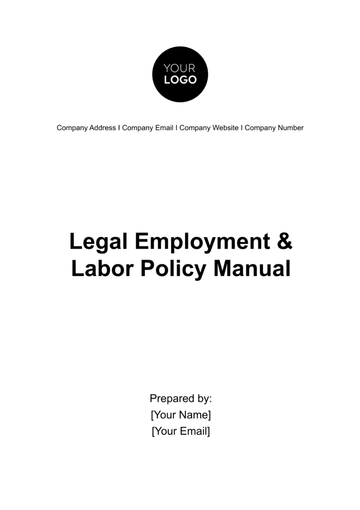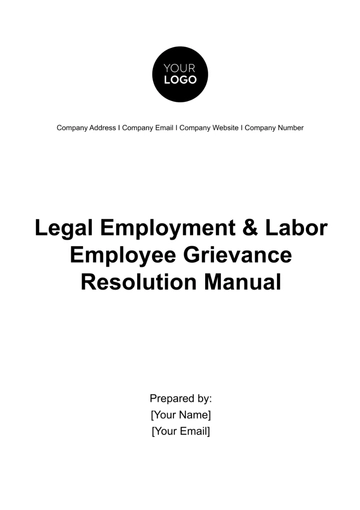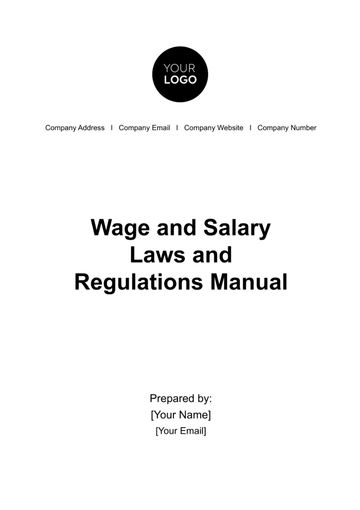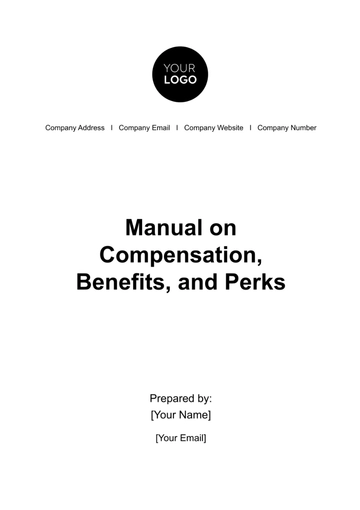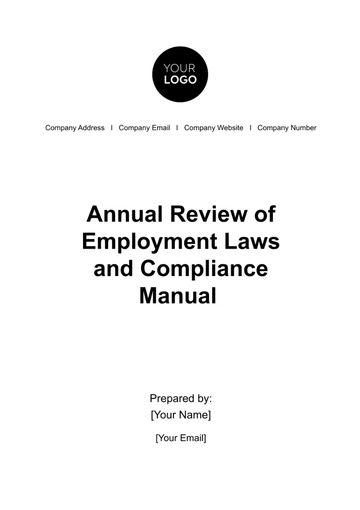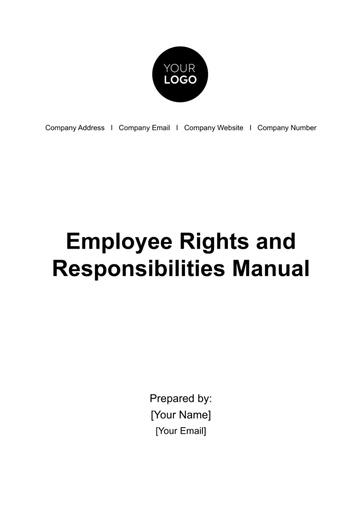Free Wage and Salary Laws and Regulations Manual HR
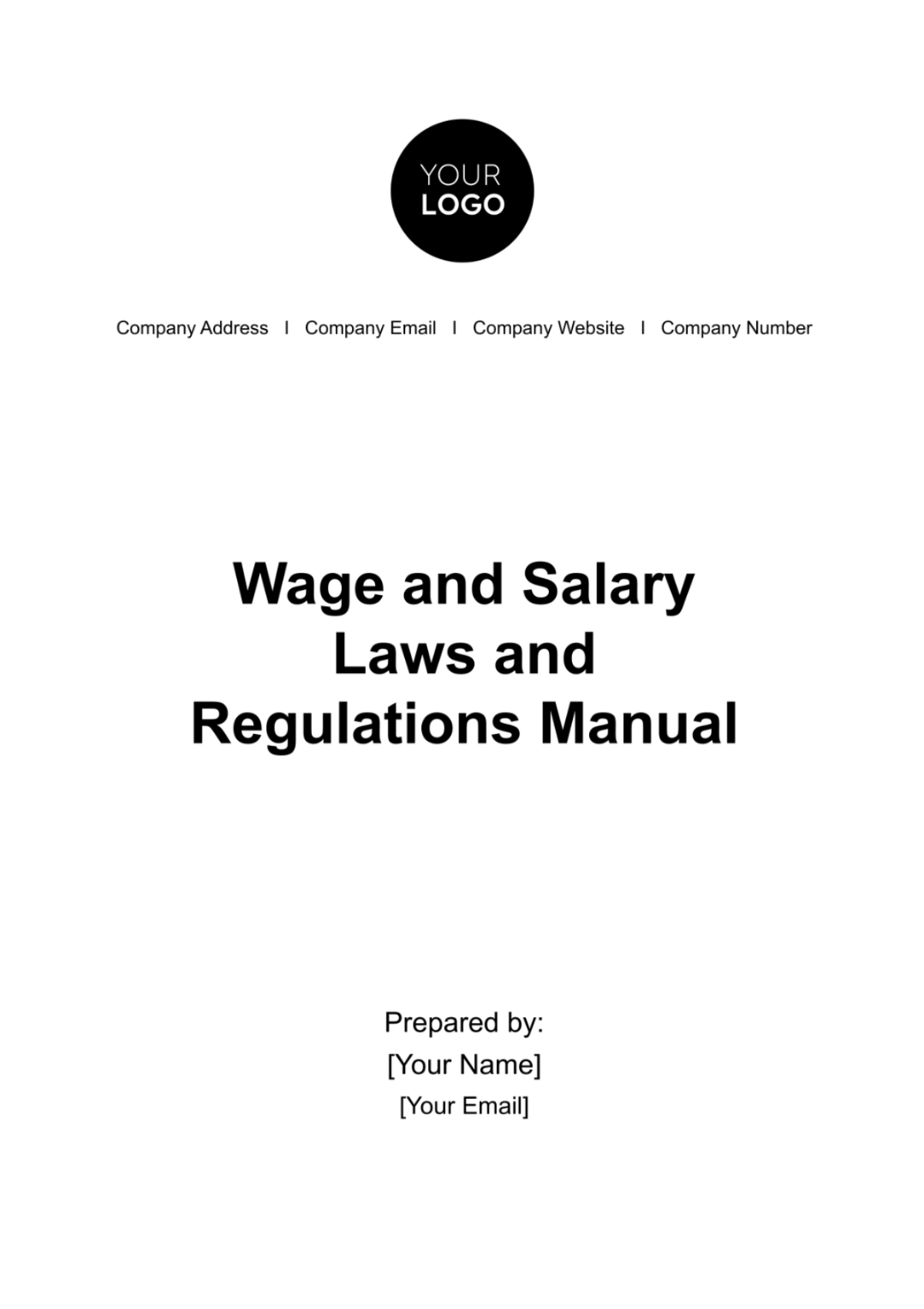
TABLE OF CONTENTS
1. Introduction..................................................................................................................3
Purpose of the Manual...................................................................................................3
Compliance Statement...................................................................................................3
2. Compensation Policy ................................................................................................4
3. Key Definitions............................................................................................................5
4. Federal Wage and Hour Laws....................................................................................6
Key provisions of the FLSA include:..............................................................................7
5. State-Specific Wage and Hour Laws........................................................................8
6. Compensation Structure............................................................................................9
Salary Compensation:....................................................................................................9
Hourly Pay Compensation:...........................................................................................10
Bonus Compensation:...................................................................................................10
7. Payroll Procedures.....................................................................................................11
Key considerations for payroll frequency:...................................................................12
Mandatory Deductions: ...............................................................................................12
1. Introduction
Welcome to the Wage and Salary Laws and Regulations Manual for [Company Name]. This comprehensive manual has been developed to serve as a vital resource for our employees, Human Resources professionals, and management teams. It outlines our commitment to ensuring compliance with wage and salary laws and regulations while fostering a fair and equitable work environment for all.
Purpose of the Manual
The primary purpose of this manual is to provide clarity and guidance on the intricacies of wage and salary laws and regulations. It serves as a reference document that empowers all stakeholders within [Company Name] to:
● Understand Wage and Salary Laws: Gain a comprehensive understanding of federal, state, and local wage and salary laws and regulations that govern our compensation practices.
● Promote Fairness and Equity: Promote a culture of fairness and equity in compensation, ensuring that all employees are compensated appropriately for their work and in compliance with applicable laws.
● Ensure Compliance: Equip HR professionals, managers, and employees with the knowledge and tools necessary to adhere to wage and salary laws, reducing the risk of non-compliance and potential legal consequences.
● Enhance Transparency: Promote transparency in compensation practices, fostering trust and engagement among our workforce.
● Facilitate Effective Compensation Management: Enable HR professionals and managers to effectively administer compensation, including salary reviews, promotions, and benefits, in accordance with legal requirements.
● Mitigate Risks: Identify potential risks related to wage and salary compliance and implement proactive measures to mitigate them.
● Empower Employees: Educate employees about their rights and responsibilities related to compensation, allowing them to make informed decisions and report concerns confidently.
Compliance Statement
[Company Name] is dedicated to upholding the highest standards of ethical and legal conduct in all aspects of our business operations, including compensation management. We are committed to ensuring compliance with all applicable federal, state, and local wage and salary laws and regulations.
This manual is a reflection of our unwavering commitment to compliance and transparency. It underscores our dedication to treating all employees fairly and equitably, regardless of their role, background, or other differentiating factors.
It is the responsibility of every employee, manager, and HR professional at [Company Name] to familiarize themselves with the contents of this manual and to abide by its guidelines. Non-compliance with wage and salary laws and regulations not only jeopardizes our company's reputation but can also lead to legal consequences.
By adhering to the principles outlined in this manual, we not only ensure the well-being of our employees but also strengthen the foundation upon which our company thrives. We encourage all employees to actively engage with this manual, seek clarification when needed, and actively contribute to a work environment characterized by fairness, equity, and compliance.
2. Compensation Policy
2.1. Compensation Philosophy
At [Company Name], our compensation philosophy is centered around the following key principles:
● Competitive Pay: We strive to offer competitive compensation packages that attract and retain top talent in the IT industry. We regularly benchmark our salaries and benefits against industry standards to ensure competitiveness.
● Merit-Based Compensation: We firmly believe that employees should be rewarded for their contributions and performance. Our compensation decisions are based on merit, taking into account factors such as skills, experience, and job performance.
● Equity and Fairness: We are committed to pay equity and fairness. Regardless of gender, race, ethnicity, age, sexual orientation, or any other characteristic, all employees should receive equal pay for equal work.
● Transparency: We believe in transparent compensation practices. Our employees have access to information about how compensation is determined, and we encourage open and honest communication regarding compensation-related matters.
● Benefits and Well-Being: In addition to competitive salaries, we offer a comprehensive benefits package that includes health insurance, retirement plans, and other perks to support the well-being of our employees and their families.
● Career Development: We invest in the growth and development of our employees. We provide opportunities for career advancement and skill development, which can lead to increased compensation.
● Compliance: We are committed to complying with all wage and salary laws and regulations at the federal, state, and local levels. Our compensation practices align with these laws to ensure legal compliance.
2.2. Equal Pay Policy
At [Company Name], we are unwavering in our commitment to equal pay for equal work. Our Equal Pay Policy encompasses the following principles:
● Equal Pay for Equal Work: We do not tolerate wage disparities based on gender, race, ethnicity, age, disability, sexual orientation, or any other protected characteristic. All employees who perform substantially similar work should receive equal compensation.
● Transparency: We maintain transparent compensation practices to identify and address any wage disparities promptly. We regularly review and audit our pay practices to ensure compliance with our equal pay commitment.
● Salary History: We do not inquire about an applicant's salary history during the hiring process, as this practice can perpetuate wage gaps. Compensation decisions are based on qualifications, skills, and the specific requirements of the position.
● Promotion and Advancement: Equal pay extends to promotions and advancements within the company. We ensure that employees are compensated fairly as they progress in their careers with us.
● Training and Awareness: We provide training and raise awareness among our employees and managers about our Equal Pay Policy. We encourage employees to report any concerns related to pay disparities.
3. Key Definitions
Understanding the fundamental concepts related to wages and compensation is crucial in ensuring compliance with wage and salary laws and regulations. The following key definitions provide clarity on essential terms:
1. Salary: Salary refers to a fixed, regular payment made to an employee for their work, typically on a monthly, bi-weekly, or weekly basis. Salary is often associated with exempt employees who are paid a predetermined amount regardless of the number of hours worked.
2. Wage: Wages, on the other hand, are compensation paid to hourly or non-exempt employees. Wages are usually calculated based on an hourly rate and vary depending on the number of hours worked during a pay period.
3. Overtime: Overtime is the additional compensation that employees receive when they work more than the legally mandated maximum number of hours in a workweek. Overtime pay is typically calculated at a rate higher than the regular hourly wage, often at 1.5 times the standard rate.
4. Exempt vs. Non-Exempt Employees: These terms refer to employee classifications under the Fair Labor Standards Act (FLSA) in the United States:
5. Exempt Employees: Exempt employees are not eligible for overtime pay and are typically salaried employees. They are exempt from certain provisions of the FLSA and are often considered exempt from minimum wage and overtime requirements.
6. Non-Exempt Employees: Non-exempt employees are eligible for overtime pay for hours worked beyond the standard workweek (usually 40 hours). They are typically paid on an hourly basis and are subject to minimum wage and overtime regulations.
7. Minimum Wage: Minimum wage is the legally established lowest hourly rate that an employer can pay to non-exempt employees. The federal government, as well as many states and localities, sets minimum wage rates, and employers must adhere to the highest applicable rate.
8. Living Wage: A living wage is a wage rate that is deemed sufficient for an employee to meet their basic needs, including housing, food, healthcare, and transportation, within a specific geographic area. It is often higher than the minimum wage and takes into account the cost of living in a particular region.
9. Prevailing Wage: The prevailing wage is the hourly wage rate, benefits, and overtime pay that is typically paid to workers in a specific occupation within a particular geographic area. Prevailing wage rates are determined by government agencies and are often used as the minimum wage rate for government contracts or public works projects.
Understanding these key definitions is vital for both employees and employers to navigate wage and salary regulations effectively. It ensures that compensation practices align with legal requirements and that employees are fairly compensated for their work while maintaining compliance with wage and hour laws.
4. Federal Wage and Hour Laws
4.1. Equal Pay Policy
The Fair Labor Standards Act (FLSA) is a federal labor law enacted in 1938. It serves as the foundation for wage and hour regulations in the United States and applies to most employees, including those in the private and public sectors. The FLSA covers various aspects of employment, including minimum wage, overtime pay, child labor, and recordkeeping.
Key provisions of the FLSA include:
● Minimum Wage Requirements: The FLSA sets a federal minimum wage that employers must pay to non-exempt employees for each hour worked. As of my knowledge cutoff date in September 2021, the federal minimum wage was $7.25 per hour. However, please note that minimum wage rates can change over time due to federal or state legislation.
● Overtime Pay: The FLSA requires employers to pay non-exempt employees overtime pay for hours worked beyond 40 hours in a workweek. Overtime pay must be at least one and a half times the employee's regular hourly wage rate. This provision ensures that employees are compensated fairly for their extra work hours.
● Exempt vs. Non-Exempt Classification: The FLSA classifies employees as either exempt or non-exempt from overtime and minimum wage requirements. Exempt employees are generally salaried and exempt from these provisions, while non-exempt employees are typically paid hourly and are eligible for overtime pay.
● Child Labor: The FLSA establishes rules governing the employment of minors, including restrictions on the types of jobs, hours of work, and conditions under which they can be employed. Child labor provisions are in place to protect the safety and well-being of young workers.
● Recordkeeping: Employers covered by the FLSA must maintain accurate records of employees' hours worked, wages paid, and other employment-related information. These records help ensure compliance with wage and hour regulations.
4.2. Overtime Pay Rules
The FLSA mandates that non-exempt employees be compensated for overtime hours at a rate of at least one and a half times their regular hourly wage rate. The key overtime pay rules include:
● Overtime Threshold: The standard threshold for overtime eligibility is working more than 40 hours in a workweek. Hours worked beyond this threshold qualify for overtime pay
● Regular Rate of Pay: Overtime pay is calculated based on the employee's regular rate of pay, which includes their base hourly wage as well as certain additional compensation, such as commissions and non-discretionary bonuses.
● Exemptions: Some employees may be exempt from overtime pay requirements, including certain salaried employees, professionals, and administrative personnel. However, meeting specific exemption criteria is necessary to qualify for exemption from overtime pay.
● Compensatory Time Off: In some cases, employers may offer compensatory time off (comp time) instead of overtime pay. Comp time should be provided at a rate of 1.5 hours of time off for each hour of overtime worked.
5. State-Specific Wage and Hour Laws
In addition to federal wage and hour laws governed by the Fair Labor Standards Act (FLSA), individual states in the United States often have their own wage and hour laws that impact employers and employees. It is important for employers to be aware of and comply with both federal and state-specific regulations. This section provides a detailed overview of state-specific wage and hour laws, including an overview of state laws, state minimum wage rates, and state overtime regulations.
5.1. Overview of State Laws
Each state in the U.S. has the authority to establish its own wage and hour laws, which may differ from federal standards. Employers operating within a specific state must be familiar with and adhere to the wage and hour regulations specific to that state. Key points regarding state laws include:
● Supremacy Clause: If a state wage and hour law conflicts with federal law and is less favorable to employees, federal law generally prevails. However, if a state law is more favorable to employees, it typically applies.
● Variances: States can set different standards for various aspects of wage and hour regulations, including minimum wage rates, overtime thresholds, and child labor laws. Therefore, it is essential for employers to understand the specific rules and requirements in their state.
● Compliance: Employers must comply with both federal and state wage and hour laws, following the regulations that provide the greatest benefits to employees.
5.2. State Minimum Wage Rates
State minimum wage rates are set by individual states and can vary widely. Many states have minimum wage rates that exceed the federal minimum wage established by the Fair Labor Standards Act (FLSA). Key points about state minimum wage rates include:
● Higher Rates: Some states have enacted minimum wage rates higher than the federal rate. Employers in these states must pay employees the higher state minimum wage.
● Annual Adjustments: In certain states, minimum wage rates are indexed to inflation and may be adjusted annually to keep pace with the cost of living.
● Local Variations: In addition to state minimum wage rates, some cities and counties have their own minimum wage ordinances with rates that exceed both federal and state levels. Employers in these areas must pay the higher local rate.
● Tipped Employees: Some states have specific minimum wage rates for tipped employees, with different rules and requirements for calculating minimum wage for employees who receive tips
6. Compensation Structure
A well-defined compensation structure is essential for attracting, retaining, and motivating talent within an organization. It provides a framework for how employees are compensated, taking into account various factors, including their role, experience, and performance. This section details the compensation structure, including considerations for salary vs. hourly pay and bonus and incentive compensation.
6.1. Salary vs. Hourly Pay
Salary and hourly pay are two distinct compensation structures, each with its own advantages and considerations.
Salary Compensation:
Definition: Salary is a fixed, predetermined amount of compensation that an employee receives on a regular basis, typically weekly, bi-weekly, or monthly, regardless of the number of hours worked.
Applicability: Salary compensation is commonly associated with exempt employees, who are not eligible for overtime pay.
1. Pros:
● Predictability: Employees receive a consistent and predictable income, simplifying financial planning.
● Professional roles: Salaried positions are often associated with managerial, administrative, and professional roles.
● Focus on outcomes: Salary encourages employees to focus on results and responsibilities rather than hours worked.
2. Cons:
● No overtime pay: Exempt employees are not entitled to overtime pay, even for working long hours.
● Less flexibility: Salaried employees may have less flexibility in adjusting their schedules to accommodate personal needs.
Hourly Pay Compensation:
Definition: Hourly pay is compensation based on the number of hours an employee works. Employees are typically paid an hourly wage or rate.
Applicability: Hourly pay is common for non-exempt employees, who are eligible for overtime pay when they work beyond a specified number of hours in a workweek.
1. Pros:
● Overtime pay: Hourly employees receive overtime pay (usually 1.5 times their regular rate) for hours worked beyond the standard workweek.
● Flexibility: Hourly pay offers flexibility in scheduling and adjusting work hours.
● Accurate tracking: It enables precise tracking of hours worked, facilitating compliance with wage and hour laws.
2. Cons:
● Income variability: Hourly employees' income may vary based on the number of hours worked, making financial planning more challenging.
● Time focus: Hourly pay can encourage employees to focus on the quantity of hours worked rather than the quality of work.
6.2. Bonus and Incentive Compensation
In addition to base salary or hourly pay, organizations often offer bonus and incentive compensation to reward and motivate employees.
Bonus Compensation:
Definition: Bonuses are one-time, lump-sum payments given to employees as a reward for exceptional performance, achieving specific goals, or contributing to the company's success.
Types: Bonuses can take various forms, including performance bonuses, signing bonuses, retention bonuses, and profit-sharing bonuses.
1. Pros:
● Motivation: Bonuses serve as strong motivators to encourage employees to excel in their roles.
● Recognition: They recognize and reward outstanding individual or team contributions.
● Talent retention: Signing and retention bonuses can attract and retain top talent.
2. Cons:
● Variability: Bonuses are often discretionary and may vary from year to year, making them less predictable.
● Not guaranteed: Employees may not always receive bonuses, depending on performance and company performance.
7. Payroll Procedures
Effective payroll procedures are critical for ensuring employees are paid accurately and on time while complying with wage and tax laws. This section outlines key aspects of payroll procedures, including payroll frequency, deductions from paychecks, and payroll taxes.
7.1. Payroll Frequency
Payroll frequency refers to how often employees are paid. The choice of payroll frequency can impact cash flow management, employee satisfaction, and compliance with labor laws. Common payroll frequencies include:
● Weekly: Employees are paid every week, typically on the same day of the week.
● Bi-Weekly (Fortnightly): Employees are paid every two weeks, resulting in 26 payrolls per year.
● Semi-Monthly: Employees are paid twice a month, often on the 15th and the last day of the month.
● Monthly: Employees are paid once a month, usually on the same date each month.
● Quarterly: In some cases, such as for contractors or freelancers, payments may be made quarterly.
● Annually: For certain employees, like executives, annual bonuses and compensation packages may be provided.
Key considerations for payroll frequency:
● Compliance: Ensure that your chosen payroll frequency complies with federal, state, and local labor laws. Some states have specific requirements for payroll frequency.
● Cash Flow: Consider the impact of payroll frequency on your company's cash flow and financial stability.
● Employee Expectations: Understand employee expectations and preferences for pay frequency to maintain employee satisfaction.
7.2. Deductions from Paychecks
Deductions from employee paychecks are amounts withheld to cover various expenses or obligations. Deductions can be mandatory or voluntary. Common deductions include:
Mandatory Deductions:
● Income Taxes: Federal, state, and local income taxes are withheld based on employee income and tax brackets.
● Social Security and Medicare (FICA): Both employees and employers contribute to Social Security and Medicare.
● Garnishments: Deductions may be required to satisfy court-ordered payments, such as child support or creditor garnishments.
● Benefits Contributions: Deductions for benefits like health insurance, retirement plans, and flexible spending accounts.
● Union Dues: If applicable, employees may have union dues deducted.
In conclusion, this Wage and Salary Laws and Regulations Manual serves as a comprehensive guide for HR personnel, managers, and employees alike. It underscores the importance of creating a workplace where compensation practices reflect the values of fairness, equity, and compliance.
By adhering to the principles and guidelines outlined in this manual, organizations can create a work environment that not only attracts and retains top talent but also promotes the well-being of all employees. As laws and regulations continue to evolve, it is essential to remain diligent, adaptable, and dedicated to upholding the highest standards of compensation and compliance.
Thank you for your commitment to the principles outlined in this manual. Together, we can create a workplace that is fair, transparent, and prosperous for all.
- 100% Customizable, free editor
- Access 1 Million+ Templates, photo’s & graphics
- Download or share as a template
- Click and replace photos, graphics, text, backgrounds
- Resize, crop, AI write & more
- Access advanced editor
Explore Template.net's cutting-edge Wage and Salary Laws and Regulations Manual HR Template. Unleash the power of an editable and customizable tool, tailor-fit for your organization's compliance needs. Effortlessly refine policies with our Ai Editor Tool, ensuring precision and flexibility in managing wage and salary regulations. Revolutionize your HR processes seamlessly.




